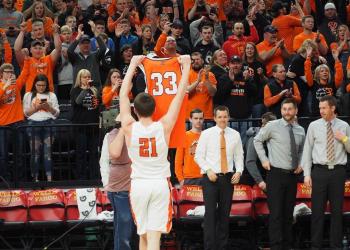John’s Journal: Shot Clocks Are Here, With Mostly Minimal Impact So Far
Many Coaches Like The Change, Especially In Late-Game Situations
Posted: Monday, December 4, 2023 - 5:49 PM
A shot clock operator.
After watching a mix of early-season girls and boys basketball games, seven or eight contests in all, I can file this report about the biggest change to the sport this season: Shot clocks are not making a huge difference.
After years of discussion, the MSHSL board of directors approved 35-second shot clocks for use in all classes of basketball, starting with this 2023-24 season. That means gyms that were not already equipped with shot clocks needed to be brought up to speed, people had to be found and trained in operating shot clocks, and everyone involved needed to be aware of the change.
For training, shot clock operators need to watch a lengthy video on the process and be aware of several situations (https://www.mshsl.org/mshsl-shot-clock-resources). It’s not as simple as resetting the shot clocks when a shot hits the rim. In some situations (11 in all), the clocks are reset to 20 seconds.
With college and professional basketball teams using shot clocks for many years, along with several other states for high school basketball, many coaches agree that it was a needed change.
“I think it's time,” said Minnetonka girls coach Brian Cosgriff, who won seven big-school state championships as the coach at Hopkins.
Minnetonka, Hopkins and the rest of the boys and girls teams in the Lake Conference used shot clocks for conference games last season, as did the West Central and Park Region conferences. Those teams got a head start on having 35 seconds to shoot.
“There really hasn't been an adjustment this year,” said Kent Hamre, girls coach at St. Michael-Albertville, last season’s Class 4A state champion out of the Lake Conference. “I think the adjustment probably has come more in practice, where we do a lot of situations with it, probably even more on the defensive side than the offensive side. Just making our kids are aware of time and possession and what to do.”
Sauk Centre used shot clocks last season in the West Central Conference and Mainstreeters girls coach Scott Bergman said it was a big success.
“Last year, our girls got to the point where when we didn't use the shot clock, they were disappointed because they just love it,” he said. “And it really didn't come into play except for at the end of the game.”
End-of-game situations were part of the impetus for using shot clocks in Minnesota, including several games in which teams simply held the ball. Among them was a 2014 Class 4A boys state tournament game between Hopkins and Shakopee that was televised.
Most talented basketball teams like to play as rapid a pace as possible, and shot clocks will only enhance that. When teams grab a rebound, race to the other end and score, that can happen in just four or five seconds.
“For sure, we love to play fast,” said longtime Alexandria girls coach Wendy Kohler. “It’s absolutely archaic for us to not have the shot clock. It’s a lot of fun.
“I think the biggest thing is letting the girls know that every second is precious. We get a rebound and we’re not going to walk out. We're going to hustle a little bit. We're going to get into our actions a little quicker.”
Not everyone involved in the sport is excited about shot clocks. Rochester Century boys coach Adam Girtman said he questions why the change was made.
“I mean, it doesn't make any sense, especially if you're a small school that struggles to get people to work the bench anyway,” he said. “How are you going to find enough guys? I think it was something the big city schools wanted for a reason, definitely. The end of the game is different, but other than that it doesn't really matter.”
Coaches agreed that shot clocks will have a major impact on the end of games, when a team that’s leading will no longer be able to stall and run out the clock. But shot clocks also put more emphasis on strong defense.
“I think the biggest thing with the shot clock is it's going to change the way teams are looking for a good shot, maybe a little bit earlier in the possession,” said Perham girls coach T.J. Super. “You get 14 seconds on the clock, you kind of have a semi-open three and you might rip it. And then I think it'll pressure teams to take bad shots in the last 10 seconds. But there's not going to be a ton of violations. The way we play, we're used to getting a shot up in the first 15 anyway. And if you're a good defensive team you can lock people up and force them into bad shots.”
Hamre said, “We’ve talked a lot about when the shot clock gets low, that's not a time to bail them out. Let's force them into a bad shot. I think it's a great addition to the game, especially at the end of the game.”
Sauk Centre’s Bergman said the added emphasis on defense and strategy makes the game even better.
“I love being able to tell my players, ‘Just play your butts off for 35 seconds on defense and you're going to get the ball back,’ ” he said. “I think it's really going to be an advantage if your team plays really good defense. I just think there's a little bit more strategy, too, which I love.”
--MSHSL senior content creator John Millea has been the leading voice of Minnesota high school activities for decades. Follow him on Twitter @MSHSLjohn and listen to "Preps Today with John Millea” wherever you get podcasts. Contact John at [email protected]





